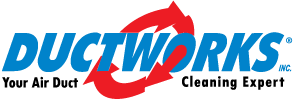 Mold contamination within air duct systems can pose detrimental health effects to building occupants if left uncorrected. If mold exists within your air ducts make a plan to investigate the source of the problem, isolate the problem area, and remove the contaminants.
Mold contamination within air duct systems can pose detrimental health effects to building occupants if left uncorrected. If mold exists within your air ducts make a plan to investigate the source of the problem, isolate the problem area, and remove the contaminants.
Understanding Mold
Molds are part of the natural environment. Molds are fungi that can be found anywhere – inside or outside – throughout the year. About 1,000 species of mold can be found in the United States, with more than 100,000 known species worldwide.
When excessive moisture or water accumulates indoors, mold growth often will occur, particularly if the moisture problem remains uncorrected. While it is impossible to eliminate all molds and mold spores, controlling moisture can control indoor mold growth. Molds are usually not a problem unless mold spores land on a damp spot and begin growing. They digest whatever they land on in order to survive. There are molds that grow on wood, paper, carpet, foods and insulation, while other molds feed on the everyday dust and dirt.
Since mold requires water to grow, it is important to investigate the source of the moisture to prevent mold growth.
Hazards of Mold in Your Ductwork
Ventilation systems are designed to distribute a recirculate air within a home. If mold growth is within the ventilation system, or near an air intake, mold spores can be spread throughout a home.
“Toxic mold syndrome” remains controversial and unproven, but experts agree that it’s best to limit exposure to molds. The most likely adverse reaction to mold is a respiratory allergic reaction in mold-sensitive people. These reactions are similar to other respiratory allergies, causing sneezing, watery eyes, nasal discharge and congestion.
Cleaning Air Ducts
Consider having the air ducts in your home cleaned if there visible mold growth inside hard surface (e.g., sheet metal) ducts or on other components of your heating and cooling system.
There are several important points to understand concerning mold detection in heating and cooling systems:
- Many sections of your heating and cooling system may not be accessible for a visible inspection, so ask the service provider to show you any mold they say exists.
- You should be aware that although a substance may look like mold, a positive determination of whether it is mold or not can be made only by an expert and may require laboratory analysis for final confirmation.
- If you have insulated air ducts and the insulation gets wet or moldy it cannot be effectively cleaned and should be removed and replaced.
- If the conditions causing the mold growth in the first place are not corrected, mold growth will recur.

